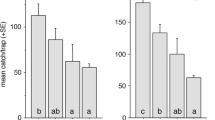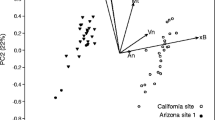Abstract
Field tests using the sawfly pheromone [3,7-dimethylpentadecan-2-ol acetate with (−)-erythro configuration (2S,3S)] were conducted near Gainesville, Florida, during 1978–1981 to determine the attraction ofNeodiprion lecontei males to baited traps with respect to time of year and time of day. Greatest numbers of males were caught during May, July, and September in traps placed within a pine stand from July 1978 to July 1979. Males were only caught between 1400 and 2000 hr on 10 dates in June and 10 dates in September–October 1980, and 10 dates in June 1981, with greatest catches from 1600–1800 hr. Catches in a synthetic-baited trap and in virgin female-baited traps were similar with respect to time of day.
Similar content being viewed by others
References
Benjamin, D. M. 1955. The biology and ecology of the red-headed pine sawfly. USDA For. Serv. Tech. Bull. No. 1118, 57 pp.
Coppel, H.C., Casida, J.E., andDauterman, W.C. 1960. Evidence for a potent sex attractant in the introduced pine sawfly,Diprion similis (Hymenoptera: Diprionidae).Ann. Ent. Soc. Am. 53:510–512.
DeGroot, P., Cunningham, J.C., andMcPhee, J.R. 1979. Control of red-headed pine sawfly with a baculovirus in Ontario in 1978 and a survey of areas treated in previous years. Report FPM-X-20, Can. For. Serv., For. Pest Mgt. Inst., Sault Ste. Marie, Ontario, Canada, 14pp.
Hochmut, R. 1972. Contribution al conocimiento deNeodiprion insularis (Cress.) (Tenthredinoidea, Hymenoptera) defoliador deFinns caribaea Morelet.Baracoa (Habana) 2:2–18.
Hopewell, W.W. 1977. Field evaluation of eight insecticides for control ofNeodiprion lecontei on red pine,Pinus resinosa. Report No. FPM-X-7, Can. For. Serv., For. Pest Mgt. Inst., Ottawa, Ontario, Canada, 20 pp.
Jewett, D.M., Matsumura, F., andCoppel, H.C. 1976. Sex pheromone specificity in the pine sawflies: interchange of acid moieties in an ester.Science 192:51–53.
Matsumura, F., Tai, A., Coppel, H.C., andImaida, M. 1979. Chiral specificity of the sex pheromone of the red-headed pine sawfly,Neodiprion lecontei.J. Chem. Ecol. 5:237–249.
Mertins, J.W., Coppel, H.C., andKarandinos, M.G. 1975. Potential for suppressingDiprion similis (Hymenoptera: Diprionidae) with pheromone trapping: A population model.Res. Popul Ecol. 17:77–84.
Morris, O.N. 1980. Entomopathogenic viruses: Strategies for use in forest insect pest management.Can. Entomol 112:573–584.
Wilkinson, R.C. 1969. Control of the red-headed pine sawfly.Sunshine St. Agr. Res. Rep. 14(6):13–15.
Author information
Authors and Affiliations
Additional information
University of Florida Agriculture Experiment Stations Journal Series 2920.
Hymenoptera: Diprionidae.
Rights and permissions
About this article
Cite this article
Wilkinson, R.C., Chappelka, A.H., Kraemer, M.E. et al. Field responses of redheaded pine sawfly males to a synthetic pheromone and virgin females in Florida. J Chem Ecol 8, 471–475 (1982). https://doi.org/10.1007/BF00987795
Received:
Revised:
Issue Date:
DOI: https://doi.org/10.1007/BF00987795




